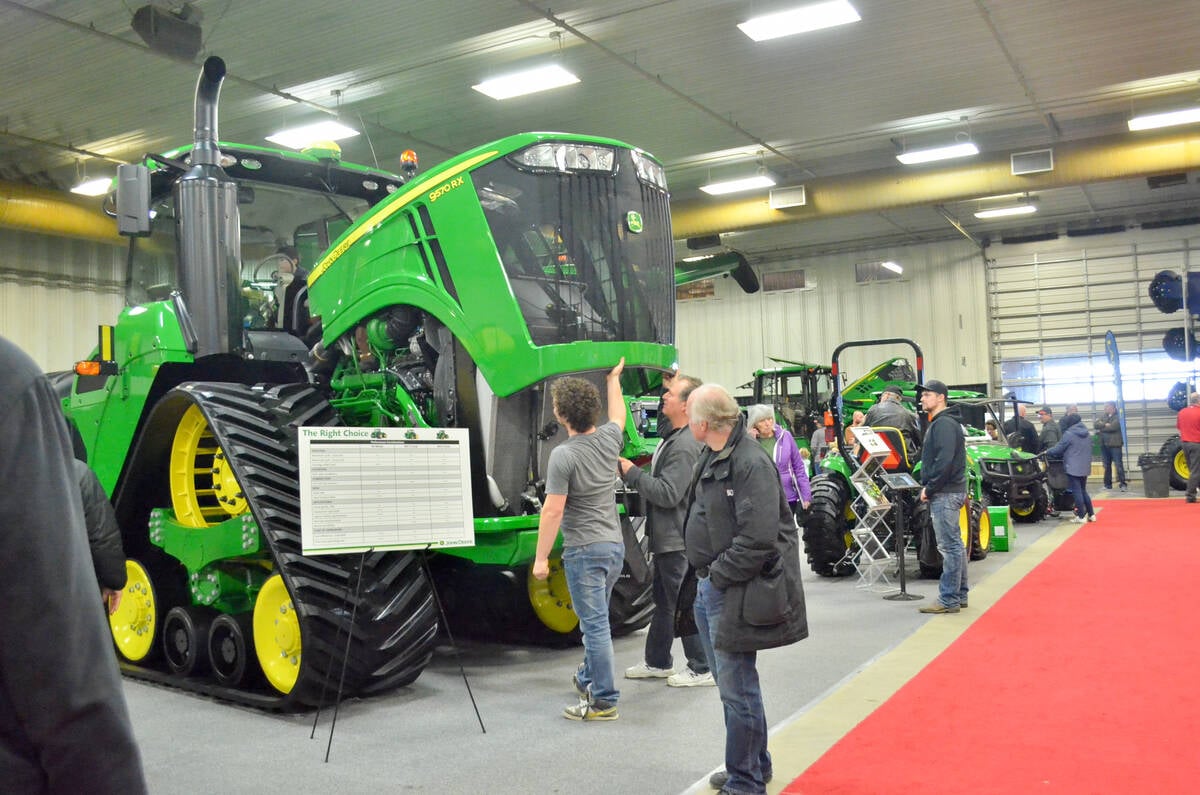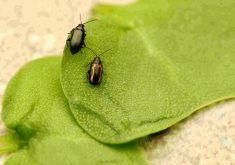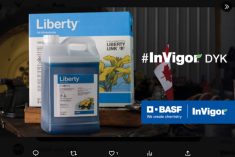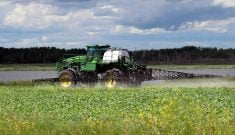Manitoba is now on the map — and this isn’t good news for farmers.
It’s the risk map for the pea leaf weevil published by the Prairie Pest Monitoring Network, and this weevil, a pest that zeroes in on faba beans and field peas, now calls Manitoba home.
“The first year we found it in Manitoba was 2019,” said John Gavloski, Manitoba Agriculture’s entomologist. “An agronomist doing some late-season crop scouting up in the Swan River area noticed a few of the weevils and she was alert enough to collect them and send them in for ID. Sure enough, they were pea leaf weevil.”
Read Also

The sneak peak of Manitoba Ag Days 2026
Canada’s largest indoor farm show, Manitoba Ag Days, returns to Brandon’s Keystone Centre Jan. 20-22, 2026. Here’s what to expect this year.
“Since then we’ve been doing annual surveys,” said Laura Schmidt, western production specialist with Manitoba Pulse and Soybean Growers. “Initially, it was in the Northwest where we were finding them and then, last year, we found them in the Southwest as far as Gladstone and into the Central region.”
Why it matters: Pea leaf weevils are a tough new pest with real control challenges.
Adult pea leaf weevils are tiny and were first found near Lethbridge, Alberta in 2000. Like so many of our pest species, they aren’t from North America. They’re an old-world species that can be found in northern Europe and ranges south all the way to the northern tip of Africa. They’re a member of genus Sitona and related to a number of weevils with similar dietary habits — they like pulses and legumes.
“They all have a very peculiar life cycle,” said Agriculture and Agri-Food Canada entomologist Hector Carcamo. “The larvae are associated with the roots of the crop. Sometimes they feed directly on the roots ,but most commonly they’ll attack the bacteria that form the nodules that fix nitrogen.”

And this is what the pea leaf weevil does. The tiny adults feed on the green leaves, leaving a characteristic notching pattern, but the larvae do the real damage. By eating the root nodule bacteria they reduce the amount of fixed nitrogen available to the plant, leaving it unable to make protein and set seeds.
If the field already has nitrogen, no problem,” Gavloski said. “But people who are seeding peas and faba beans won’t be putting on as much nitrogen because the plants can fix their own.”
“In faba beans we have documented yield reductions that are quite substantial,” Carcamo said. “Sometimes half a tonne per hectare is possible, so that’s quite a lot of money.”
Limited exposure
Fortunately, there aren’t many pea leaf weevils in Manitoba yet, but farmers and agronomists should be aware of them and keep their eyes open. Oddly enough, you’ll probably see the tell-tale damage but won’t see the weevils themselves because they’re so small. Therefore it helps to know their habits. For a start, they overwinter as adults in field vegetation.
“They’re emerging in the spring from our perennial forages as well as our ditches and shelterbelts,” Schmidt said. “In the early spring they’ll fly to peas and faba beans, their host crops.”
They’re specific to faba beans and field peas. Although the adults will feed on other plants during the fall, the larvae are tied to these two crops. Carcamo said a grad student tried forcing the weevils to breed on other legumes to see if the larvae would attack them too.

“We tried them on alfalfa and we got nothing out of alfalfa. We tried a vetch also, I can’t recall which one, but we couldn’t get anything out of the vetch,” he said. “We tried soybean and we got only one larva out of that so soybean might be an occasional host but not really an important one. They’re very specific.”
Once they start feeding, they leave a distinctive, almost scallop-like notch pattern on the leaves. This feeding pattern lets you know they’re around and you may have a problem. The sad thing is that you may not be able to do much about it.
“There are foliar insecticides that are registered for pea leaf weevil control,” Schmidt said. “They’re ultimately ineffective partially because those eggs have already been laid, so the damage is already done. It’s a revenge spray.”
Besides, there may be several waves of emerging adults. If you spray, you may only be killing one wave of them. There will soon be others.
“There are insecticide seed treatments that will provide some control, and I say some because it’s not complete control,” Schmidt said. “The thiamethoxam seed treatment is only killing a third of the weevils in the field.”
Difficult foe
Since spraying is not the answer and seed treatments are only partially effective, managing the pea leaf weevil may turn out to be a real chess match based on what observations a farmer or agronomist can make. It starts with the history of the field and previous problems with pea leaf weevils. They like to overwinter in perennial forages. If you had a problem last year and there’s an alfalfa field nearby, you may want to consider a seed treatment for field peas and faba beans.
You may also consider the weather. They like it moist. With this season’s snow melt and subsequent rains it may be a good idea to watch for them next year. On the other hand, they don’t like it dry.
“In Saskatchewan, with some of their surveys, they saw their numbers go down quite a bit in some of the drier years that we had over the last few years,” Gavloski said. “Manitoba is predicted to be an area where they should do quite well because we do have the climate conditions that would favour them. We’ll just have to wait and see how the population establishes here.”
What is a weevil?
If you open an entomology textbook, find the index and and look up ‘weevil,’ you’ll find quite a stack of them, most of named for a plant grown either in agriculture or forestry.
There’s cabbage seed pod, carrot, clover seed, coffee bean, cranberry… it covers most of the alphabet from alfalfa to white pine.
It’s obvious that we have a storied history with weevils. In the early 1900s the cotton boll weevil decimated the cotton crop in the southern United States, inspiring a number of blues singers right up to the Boll Weevil Song made famous by Brook Benton in 1961.
The University of Arkansas-Monticello even uses the infamous boll weevil as the team name and their mascot, Weezie the Weevil, leads the cheers as they take the field in the Boll Weevil Stadium.
For as long as humanity has been farming, we’ve been plagued by weevils in one form or another.
Weevils are beetles and beetles make up close to 40 per cent of all insect species. We don’t know how many different types of beetles there are but there may be as many as two million.
We’re not even certain how many different types of weevils we have because we’re still arguing about what a weevil is.
We do agree that the true weevils belong to the family Curculionidae and there are only about 83,000 different species that we know of. When you’re talking insects, you’re talking huge numbers.
The true weevils are also called ‘snout beetles’ because of their distinctive long snout. Their antennae also have odd, almost elbow-like joints. Beyond that there are huge variations in size and shape.
Most are plant eaters and some can be serious pests in both agriculture and forestry. Having said that, they can also be used for biological control of pest plants such as purple loosestrife which we now keep in check with the loosestrife flower weevil and the loosestrife root weevil.














